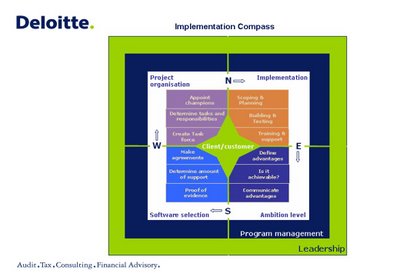How to implement CPM projects succesfully?
The Standish Group reported in 1994 (the Chaos-report) that a third of all ICT-related implementations failed or were cancelled. Recent research (Ernst & Young) shows that six out of ten ICT-related projects go wrong, despite the fact that organizations have learned to work thematically and Prince2 has been generally accepted as the project management methodology.
That many CPM-implementation projects do not deliver on time, within approved budget and expected quality is no surprise to me, what is more surprinsingly is the fact that the problem is seen as a managerial problem (Prince2). I believe that the main problem is caused by a lack of understanding of the impact and preconditions of any kind of ICT-implementation project. The characteristics of any ICT-implementation project is that they are once-only, commitment sensitive and that they have a major impact on the way 'things are done'. In our CPM practice we do not soley trust on Prince2; we also believe that for a successful implementation the client has to go through different stages of what we call the 'Implementation Compass’.  The Implementation Compass is based on the following four parts: the house, the clockwork, the clockface and the direction indicator. Leadership is 'the house' for every implementation project. It is the basis for present and future success. Leadership has to be present in every stage of the implementation project. Without leadership the project will surely fail. Program management is the clockwork. It connects the house (leadership) with the clock face (the position within the implementation project). The clock face dictates the position within the implementation project. It gives the steps that have to be taken. The direction indicator shows which activities per stage have to be undertaken by the client. A short summay of the Implementation Compass is given below.
The Implementation Compass is based on the following four parts: the house, the clockwork, the clockface and the direction indicator. Leadership is 'the house' for every implementation project. It is the basis for present and future success. Leadership has to be present in every stage of the implementation project. Without leadership the project will surely fail. Program management is the clockwork. It connects the house (leadership) with the clock face (the position within the implementation project). The clock face dictates the position within the implementation project. It gives the steps that have to be taken. The direction indicator shows which activities per stage have to be undertaken by the client. A short summay of the Implementation Compass is given below.
Leadership is not the same as project or program management. Leadership exists out of a number of steps that are necessary to realize change succesfully. Leadership defines how the future looks like, aligns people with that vision and inspires people to achieve that vision despite the obstacles.
To align Leadership with the four stages of an implementation project, program management can be necessary when the implementation project is strategic or when the change is extensive or has to be achieved under time pressure.
Ambition level (from East to South). The business case has to give a clear answer on what the advantages are, not only measured in financial terms but also in qualitative tems. It should also state the vision on CPM over the next 3 - 5 years. The next step is to test the whole business case on achievability (a sanity check) per year and phase. The last step is communication. Always make sure that everyone involved directly and indirectly is informed on the advantages and expectations (explain the Why and What).
Software selection (from South to West). In this stage it is necessary to measure what the track record is of the suppliers on the short list. How proven is their technology and what is the response time and qualtity of support? And finally always make sure to make profound legal contracts with supplier and internal ICT-department. In these contracts make clear what the tasks, responsibilities and authorizations are for all involved parties. Make also sure what the consequences financially are for all parties involved in the situation of no compliance to the agreement.
Project Organisation (from West to North). The project organisation has to achieve the intended advantages of the business case. The client has to create a task force kind of project team, for every role determine the tasks and responsibilities and appoint champions with enough reputation to get things done.
Implementation (from North to East). Implementation knows the following standard phases. Scope, planning and functional and technical design, building and testing, training and support go-live. During the implementation, configuration of the application management organisation is an aspect that needs special attention. The specific point where you put the "border" between the system-related responsibilities of accounting and those of IT is to a large extent arbitrary and can therefore vary from one implementation to the next, but the key criteria we use are:
1. The faster the response required, the more the support needs to sit with accounting.
2. The more technical the type of issue, the more it needs to sit with IT.
For all stages within the Implementation Compass we have developed multiple check lists that are easy use. We use it as an evaluation tool for CPM implementations, but also as a tool to guide the client through this difficult change process.
Author: Edwin van den Broek (edvandenbroek@deloitte.nl)
